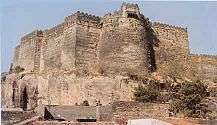Chudasama Dynasty
| Chudasama dynasty | ||||||||||
| ||||||||||
| Capital | Vanthali (Present-day Junagadh) | |||||||||
| Religion | Hinduism | |||||||||
| Government | Monarchy | |||||||||
| King | ||||||||||
| • | c. 875 - c. 907 | Chuda Chandra | ||||||||
| • | c. 940 - c. 982 | Ra Graharipu | ||||||||
| • | c. 1025 - c. 1044 | Ra Navghan | ||||||||
| • | c. 1044 - c. 1067 | Ra Khengar | ||||||||
| • | c. 1451 - c. 1472 | Ra Mandlik | ||||||||
| History | ||||||||||
| • | Established | 875 | ||||||||
| • | Disestablished | 1472 | ||||||||
| ||||||||||
The Chudasama are a Rajput clan found in the state of Gujarat in India. According to historian Virbhadra Singh ,Chudasama appear to have come over from thatta capital of sindh. The clan descent from samma-yadava line. Chudasamas are entered the peninsula of Kathiawar in about 875. 'Raa' was the title adopted by these Rajputs. The dynasty were longest ruler of junagadh.
History
After the destruction of valbhi dynasty of saurashtra , sorath area became independent. During this time the vanthali area was ruled by walaram a chavda rajput king. Raja Wala Ram had no sons, and the question arose as to who should succeed him after his death. It happened that among the Hindu tribes which had migrated Southward before the encroachments of the Mahomedans was that of the Samas, who settled at Saminagar (now Nagar Thatha), in Sindh. Wala Ram's sister had been married to the chief of the Samma tribe, and her son, Ra Chuda, was selected to follow his uncle at Wamansthali.
Accordingly, at Wala Ram's death, in about A.D. 875, Ra Chuda founded the Chudasama dynasty, adding the name of his father's tribe to his own name.The Chudasama quickly became very powerful, and from an inscription at Dhandhusar we learn that the rulers of all neighbouring countries regarded them as paramount. The dynasty continued to hold sway from 875 A.D. to 1473 A.D. nearly six hundred years. Having capital vanthali and junagadh alternatively.[1]
Uparkot Fort

Uparkot was established by mauryan dynasty, but it lost its value when capital of kathiawar moved from junagadh to valbhi ( modern village of valbhi dynasty ). Chudasama settled around junagadh from 875 , it was their ruler Ra graharipu ( c.940-c.982 ) , who hacked the citadel free from jungle.From the evidence contained in the Devyashray at Junagadh we may safely conclude that Ra Graharipu laid the foundations of the citadel as it now exists.
After several Ra Chudasama of Wamansthali had ruled, a woodcutter one day managed to cut his way through the forest and came to a place where stone walls and a gate existed. Near by sat a holy man in contemplation, and on being asked by the woodcutter the name of the place and its history, he replied that its name was " Juna " — old. The woodcutter returned by the way he had come to Wamansthali, and reported his discovery to the Ra, who ordered the forest to be cleared away. This being done, the fort came into sight. But there was none who knew its history, or who could tell more than the holy man had told the woodcutter. So the place became known as " Junagadh " for want of a better title. If this story is to be believed, either Ra Graharipu rediscovered an ancient stronghold or else after he had built the fort it was abandoned and afterwards found again by a later ruler Ra Navghan - 2 ( c.1067-c.1098 ) who transferred Chudasama Capital from Wamansthali to Junagadh. The Present walls were built by Chudasama rajputs.[2]
Adi Kadi Vav and Navghan Kuvo


Adi Kadi Vav and Navghan Kuvo are probably oldest step well in India.These two step wells represents the highest architecture achievements of chudasama rule.Navghan kuvo was built by Ra Navghan - 2 ( c.1067-c.1098 ). During this time Uparkot was attacked many times. It been sieged by sixteen times , with one siege lasting over a decade. And its Navghan Kuvo that often hid defending armies , who would then creep out at night to reduce any unsuspecting ingressing forces.,[3]
Ra Khengar Vav
The construction of this well is attributed to Ra Khengar I, who reigned from about a.d. 1098-1125.On the road to Vanthali road about five miles from Junagad and four and a quarter miles from Vanthali is the Khengar Vav or well which never ceases to yield water even in famine years. The well is much ruined but must have been a most beautiful one when in repair. Even now the carving which remains is most delicate and the proportions of the pillars &c. very graceful. This well evidently originally contained an inscription as there are two niches for an inscription on either side as one descends the steps to the water, but they have been removed, and it is not known what has become of them.
See also
Sources
- ↑ Singhji, Virbhadra (1994-01-01). The Rajputs of Saurashtra. Sangam. ISBN 9780861323272.
- ↑ Ward (1998-01-01). Gujarat–Daman–Diu: A Travel Guide. Orient Longman Limited. ISBN 9788125013839.
- ↑ Jha, Saurav; Roy, Devapriya (2015-05-15). The Heat and Dust Project: The Broke Couple's Guide to Bharat (in Arabic). HarperCollins India. ISBN 9789351367505.
- ↑ "Chudasama Rajput Parivar Dhandhuka Ahmedabad". www.chudasamarajputparivar.org. Retrieved 2016-02-23.